What Is Symbolism in Writing?
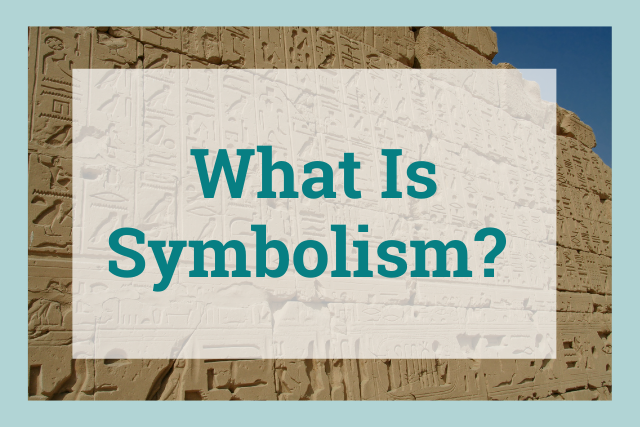
What does this mean?

What about this?

I’m going to guess that everyone got a 100% on that pop quiz and answered:
Wi-Fi
Peace
Sometimes, words aren’t needed to convey meaning. Symbols do the work for them.
What Is a Symbol?
A symbol is something that represents something else.
It is usually physical, such as an object or marking, though it doesn’t have to be; it could be an act or action.
A symbol holds more than the literal meaning of itself. A wedding ring is a circular piece of metal, but it isn’t just a piece of metal. It represents commitment, unity, and love.

Often, we think of symbols as somewhat mysterious elements of literature or art that we must unpack and dig through in order to understand their meaning. Sometimes that’s true! You remember the raven from Edgar Allan Poe’s The Raven right? Sure, the raven was a bird, but it’s also a symbol of death or loss or insanity or all of those concepts.
But symbols are also part of our everyday lives. McDonald’s golden arches tell us where to find fast food, and hearts let us know we’re loved, as does an XO.
Punctuations marks are symbols. That period you just passed made you stop for a moment before you continued reading this sentence; it let you know the thought was complete.
Even these letters you are reading are symbols. They represent sounds which, when put together, create words that represent meanings. How meta!
Seriously though, recognizing that you already understand and use symbolism on the regular can make recognizing it in art and literature, or incorporating it into your own work, less intimidating.
When Do We Use Symbolism in Our Daily Lives?
Some symbols have widespread common—sometimes even universal—meanings. Other times, an object can be symbolic of one thing in one context and represent something else in another.
To get ourselves warmed up for our symbols in the arts discussion, let’s investigate some familiar real-world symbols.
What Are Some Examples of Real-Life Symbols?
1. Emojis
The situation: you send me a text saying you got a new job! This is what I text you back:

You ask me how my day at the Department of Motor Vehicles (DMV) went and I text you back:

Emojis provide symbolic representations of our feelings or thoughts and we use them with ease—not so mysterious at all.
2. Traffic Symbols
Though road signs and symbols may have slight variations from country to country, for the most part, drivers share an understanding of traffic lights and their symbolic colors:
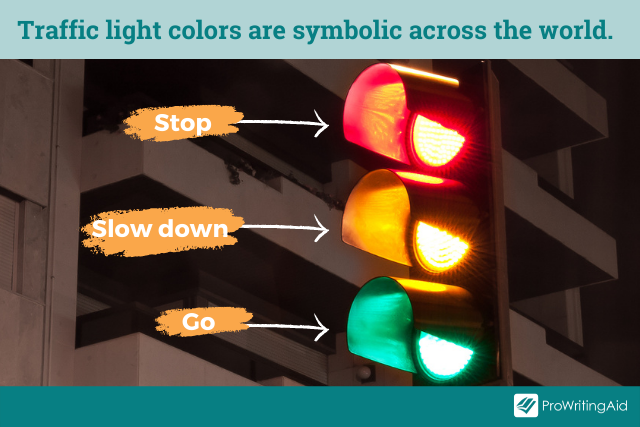
Red = stop
Amber = light about to turn red, so slow down and be careful
Green = it’s your turn to go
If there was no symbolic meaning behind those literal colors, we’d have mayhem on the roads.
3. Flags
If you’ve ever watched the Olympics, you’ve seen all participating countries’ flags waving proudly during the opening ceremonies or raised during the award ceremonies. Those flags are symbols representing their respective countries.
If you look deeper into each flag, you’ll find that their colors and designs also have symbolic value.
For example, the flag of the United States has 13 stripes alternating red and white, and 50 stars on a blue field. The stars represent each of the 50 states (the original flag had only 13 stars, one for each original colony).
As for the stripes and colors, “The thirteen stripes, resting side by side, represented the struggle for independence; red stood for valor, white signified purity and blue represented loyalty” (Michael J. Cusick, New Your Assembly).
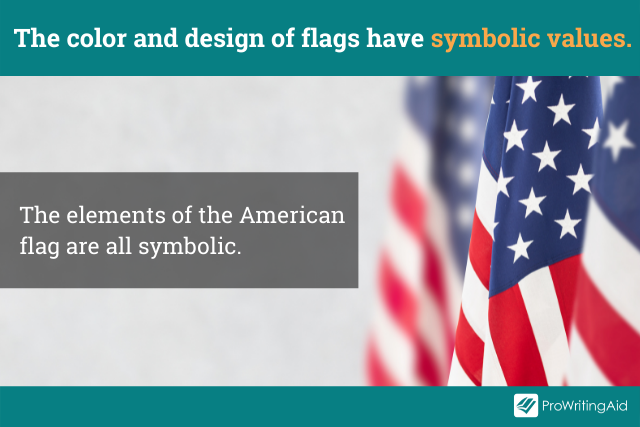
Countries are not the only entities represented with flags. The rainbow flag is a well-known symbol of the LGBTQ community with the colors representing both the diversity and the unity (through the rainbow) of the community.
Many other communities and organizations have representative flags.
4. Cultural and Religious Symbolism
Though a culture is represented through a variety of symbols, consider the symbolic actions adopted by cultures; it’s a good idea to read up on these actions before you travel!
For example, raising your thumb is a symbol meaning “great!” or “way to go” in some cultures, but in others, it has more of a “screw you!” meaning.
In the United States, making a “V” with your first and second fingers is a peace sign. If you turn that “V” backwards (palm facing you) in the UK, you’re flashing a symbol of a serious insult.
If you want to brush up on other hand symbols, read the full Reader’s Digest article here.
Religious symbols are recognizable even by those who don’t practice the faith represented.
- Christianity is represented by the Christian Cross
- Judaism is represented by the Star of David
- Islam is represented by the Star and Crescent
- Hinduism is represented by the Om
- Buddhism is represented by the Wheel of Dharma
As with flags, there are layers to these symbols. The flag represents a country as the religious symbols identify a religion. And just as a flag’s designs and colors carry symbolic meaning, the religious symbols reflect core elements of their respective belief systems.
5. Political Actions as Symbols
We generally think of symbols as things—objects, items, or images. But actions can also be symbolic, beyond hand gestures.
For better or worse, political leaders stage symbolic actions.
One country’s leader may meet with another not because there is so much to discuss (though there probably is), but so they can show the rest of the world they are strong allies
During the COVID-19 pandemic, former US President Trump contracted the disease. Upon his return to the White House, he stood on the balcony facing outwards, standing with his shoulders back and head high, and promptly removed his mask. Certainly, there was a message there.
Going back several centuries, King Henry VIII and Francis I held what became known as the “Field of Cloth and Gold.” An extravagant meeting in which tents, costumes, and decorations were made with cloth embellished with gold—a symbolic display of the monarchs’ wealth and power.
6. Ribbons as Symbols
Ribbons, either actual ribbons you can pin to your clothes or magnetic versions for your car, serve as symbols for different causes. They are used to raise awareness or money or both for the causes they represent.
7. Interpersonal Actions as Symbols
On a happier note, love often prompts symbolic actions
- Sending someone a dozen red or pink roses (unless they prefer another color; get what they love!)
- Giving someone the bigger slice of cake
- Holding hands
You get the idea. These actions are simple, but they hold meaning beyond the acts themselves.
Love is not the only emotion that generates symbolic action. There are plenty of other ways we show that “actions speak louder than words.” Our actions serve as our expression:
- You’re angry at your sibling and destroy their favorite toy
- You’re ready to make a deal and shake hands to seal it
- You’re ready to quit smoking and flush all your cigarettes down the toilet
- You’re fasting for one day a week in an effort to raise awareness and end world hunger
From the ordinary to the dramatic, our lives, and those of literary characters (those we read or create) are filled with symbolic action.
What Is Symbolism in Literature?
Symbols appear often in film, literature, and visual arts. Sometimes their meanings are clear, other times they require some investigation.
Need an Example?
Do you remember the green light in F. Scott Fitzgerald’s The Great Gatsby? Many see it as a symbol of Gatsby’s ever-burning love for Daisy and/or of his single-minded, ever-hopeful quest to obtain her. Others see it as representing the money and greed that drove Daisy’s actions. Some see it as representing both of those concepts.
A symbol can represent one entity in one work or context, but something differently in another, so it’s important not to generalize too quickly.
For example, a flock of birds in full flight might symbolize freedom in one film or story. Those birds in another context could symbolize incoming danger.
Symbols provide audiences with opportunities to interpret or attribute meaning, especially when it comes to symbolism in the arts, which is what we’ll focus on now.
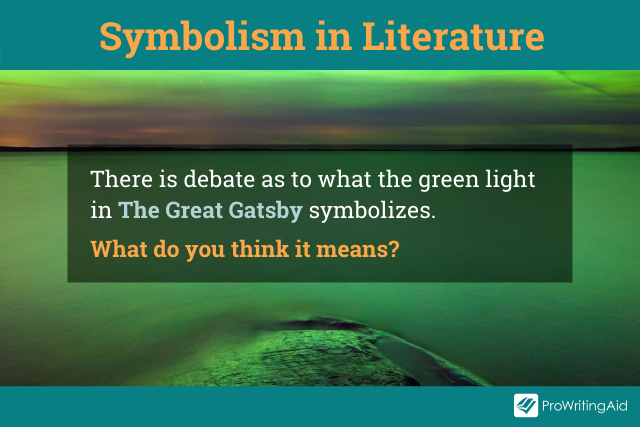
Why Do Writers Use Symbolism?
Every writer is different, but here are four key reasons why a writer may use symbolism.
Symbols:
- Carry emotional impact that intensify the audience’s engagement with the work
- Can elevate an audience’s understanding of a character’s attributes or the theme/s in a work
- Allow artists to say more with fewer, or even no words
- Create a sense of intrigue or mystery and connect themes
Just as emojis help express more than our words in texts, symbols allow writers and artists to use images, objects, sounds, nature, or people (or whatever else they choose) to convey ideas more poignantly.
A writer may frequently opt for a particular type of symbolism (e.g. weather or color symbolism), contributing to their unique style.
Sometimes, the significance of a symbol isn’t immediately clear. But as a story unfolds and the symbol reappears, we discover its meaning. This can be especially satisfying in a mystery novel, but is also an effective tool for showing how characters’ mindsets change over the course of a story.
What Are Some Examples of Symbolism in Books and Movies?
While not everything in literature and film has to be symbolic, authors and directors often make certain choices to add deeper meaning to their art.
Here are some famous examples:
Jaws (1975)
Have you seen the movie Jaws? Even if you haven’t, I’ll bet you’re familiar with the shark’s theme song: DUN-dun-DUN-dun-DUN-dun. That simple score is symbolic of the shark’s presence and the imminent danger. If you play that song while I’m in a swimming pool, I’m out!
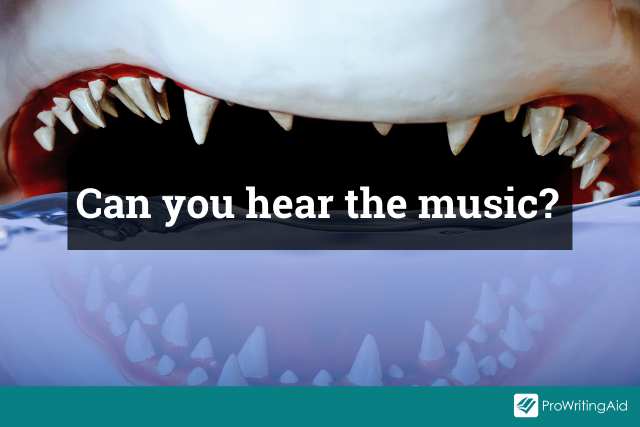
The Negro Speaks of Rivers, Langston Hughes
The rivers mentioned in this poem are symbolic, providing a collective heritage of Africans and African Americans represented through the speaker.
Heathers (1989)
The movie features three characters, each named Heather and each with a signature color:
- Heather Chandler, the “Queen” of the Heathers wears red, a power color which is appropriate as she holds the social power and is the ultimate mean girl.
- Heather Duke wears the color green, which represents jealousy and greed. Indeed she is jealous of Heather Chandler’s status and when Heather Chandler dies, Heather Duke quickly assumes that “red” status in her clothes and her demeanor.
- A third Heather wears yellow, the color of cowardice and friendship. And while she is the friendliest of the three (though that’s not saying much), she is too intimidated by them to do anything but follow their lead and orders.
The Legend of King Arthur
The sword, Excalibur, which the legendary King Arthur pulled from the stone, symbolizes divine kingship and extraordinary power. His possession of that symbolic sword elevates his status and authority.
The Art of Frida Kahlo
Like many visual artists, Frido Kahlo’s works are full of symbolism. In one of her self-portraits, Kahlo included symbols of hope and new life (hummingbird) and of bad luck (black cat). What did she believe was waiting for her? For more examples of her uses of symbolism, access this Daily Art Magazine article.
Oranges in Film
I can’t take credit for this observation, but according to Stephen Barker of Screenrant an orange, or oranges, are placed by people who are soon to die.
The Shawshank Redemption by Stephen King
King could have told us how Andy’s Rita Heyworth poster represented beauty in the midst of horror, or that his tunneling behind it gave him purpose and sanity in the midst of chaos, but I don’t think the feelings generated by the symbols themselves could be matched by a straight-on telling.
Writers use symbolism to make their work more evocative. Symbols are supposed to make you feel something beyond what can be achieved by just telling you what to feel.
Symbolism is a great technique to use if you’re practising Show, Don’t Tell. This classic writing advice tells us to show our readers what is happening—not just tell them up front.
If you want to inject more symbolism into your work (and avoid telling your reader what to think!), try ProWritingAid’s Emotional Tells check in the Style Report.

You’ll see where you have used emotion tells in your work so you can replace them with something more symbolic instead.
Try the Emotional Tells check with a free ProWritingAid account.
Other times, artistic symbolism may be more subtle. Perhaps water is used to represent a rebirth or new life. A sunset may symbolize an ending. A stormy night may symbolize someone’s emotional torment. (Or... it may just be a stormy night! There doesn’t always have to be a symbol.)
How Do You Identify Symbolism in Literature?
It’s easy to get symbol-happy and attribute symbolic meanings where they don’t necessarily exist. When you’re interpreting a piece of art or literature, it can be useful to think of these synonyms.
Hopefully, this list of alliterative words will give easy-to-remember guidance.

Repetition: is there an object or image, color, etc. that is repeated often in the work? If so, there’s a possibility that the element has symbolic value and is worth consideration. For example, in William Golding’s Lord of the Flies, the conch shell has many appearances; the rule is that the one who holds it is the one who can speak. It symbolizes civility and order.
Revelation: Does the object, image, color, etc. (either a repeated one or even an impactful single-appearance one) serve to reveal something about the character, event, etc.? For example, Lady Macbeth has all of that blood on her hands (in reality and then figuratively) symbolizing her murderous nature and her guilt.
Research: Is there an object, image, color, etc. that you suspect might have significance but aren’t sure? Look it up!
If you’ve seen Bong Joon Ho’s Oscar winning thriller Parasite (and even if you haven’t but are interested in symbolism), read this article from the Hollywood Reporter.
It’s an example of how research brings insight, helping us discover the meanings of symbols, and how there is room for flexibility within our interpretations.
What’s the Difference Between Allegory and Symbolism?
An allegory is a story in which the characters, settings, and/or situations represent—or symbolize—a larger point about the human experience or society. While you can enjoy the story on its own, there is a deeper meaning represented and intended for exploration.
C.S. Lewis’ The Lion, the Witch, and the Wardrobe is an example of an allegory. Though it can be read simply as the fantastical experiences of four young siblings in another world, it is representative of the story of Christ, his crucifixion, and resurrection.
Other allegories
- Aesop’s Fables
- George Orwell’s Animal Farm
- Toni Morrison’s God Help the Child
- Robert Louis Stevenson’s The Strange Tale of Dr. Jekyll and Mr. Hyde
- Yann Martel’s Life of Pi
Allegory and symbol do share a common function in that they both represent other things. However, in an allegory, the story is symbolic as a whole. Then, within that symbolic story, certain parts are symbolic. For example, characters, objects, and events in the story carry symbolic values that contribute to the symbolic meaning of the story overall. The symbolism in an allegory is comprehensive.
How Can I Use Symbols in My Writing?
Clearly, symbolism adds layers, interest, and artistry to works of art. If it comes across as forced, though, symbolism can make your work seem less authentic, so take steps to ensure that your symbols are meaningful, natural elements of your work.
For example, if you’re writing a short story, establish your plot, characters, and setting first. Know what theme you’re working to convey. Flesh out those elements. Then, see where symbolism would enhance those elements and rework your story with symbolic additions.
Also, know the purpose of your symbols. Are you looking to add some signature elements to reveal character traits? In The Great Gatsby, Fitzgerald’s Daisy, the “golden girl” had a little gold pencil, among other golden descriptions. Even her insignificant possessions project wealth.
Are you trying to create an atmosphere of doom? Then consider how you can infuse your setting with mood-setting symbolism.
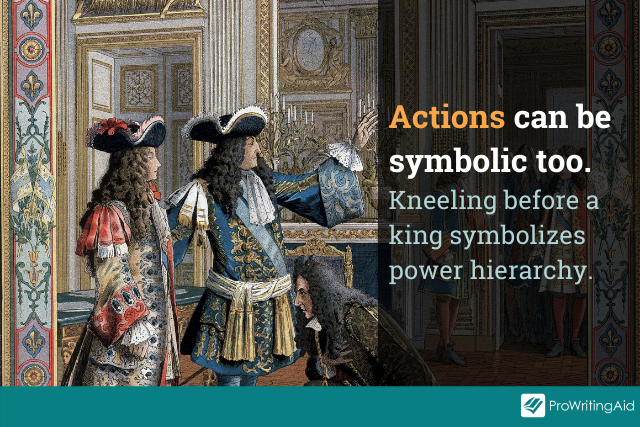
Why Should I Use Symbolism?
Symbolism, like metaphors, personification, other literary devices and forms of figurative language add depth, artistry, and thought-provoking substance to a work.

To strengthen your recognition and understanding of symbolism, pay attention to the symbols you encounter and use in your everyday life. In doing so, you’ll sharpen your powers of observation and insight as you consider how those symbols work.
Then, as you read literature or view films, or create your own masterpiece, you’ll have increased perception and confidence for recognizing, interpreting, or developing more complex literary symbols.
Get going! The symbols are waiting for you! You’ve got this!